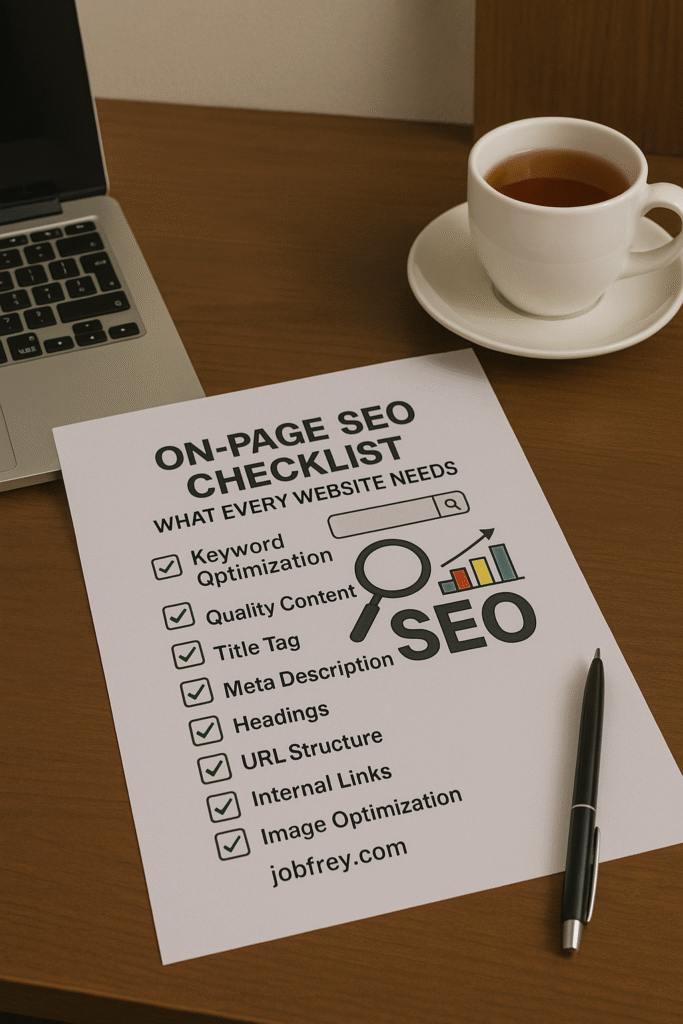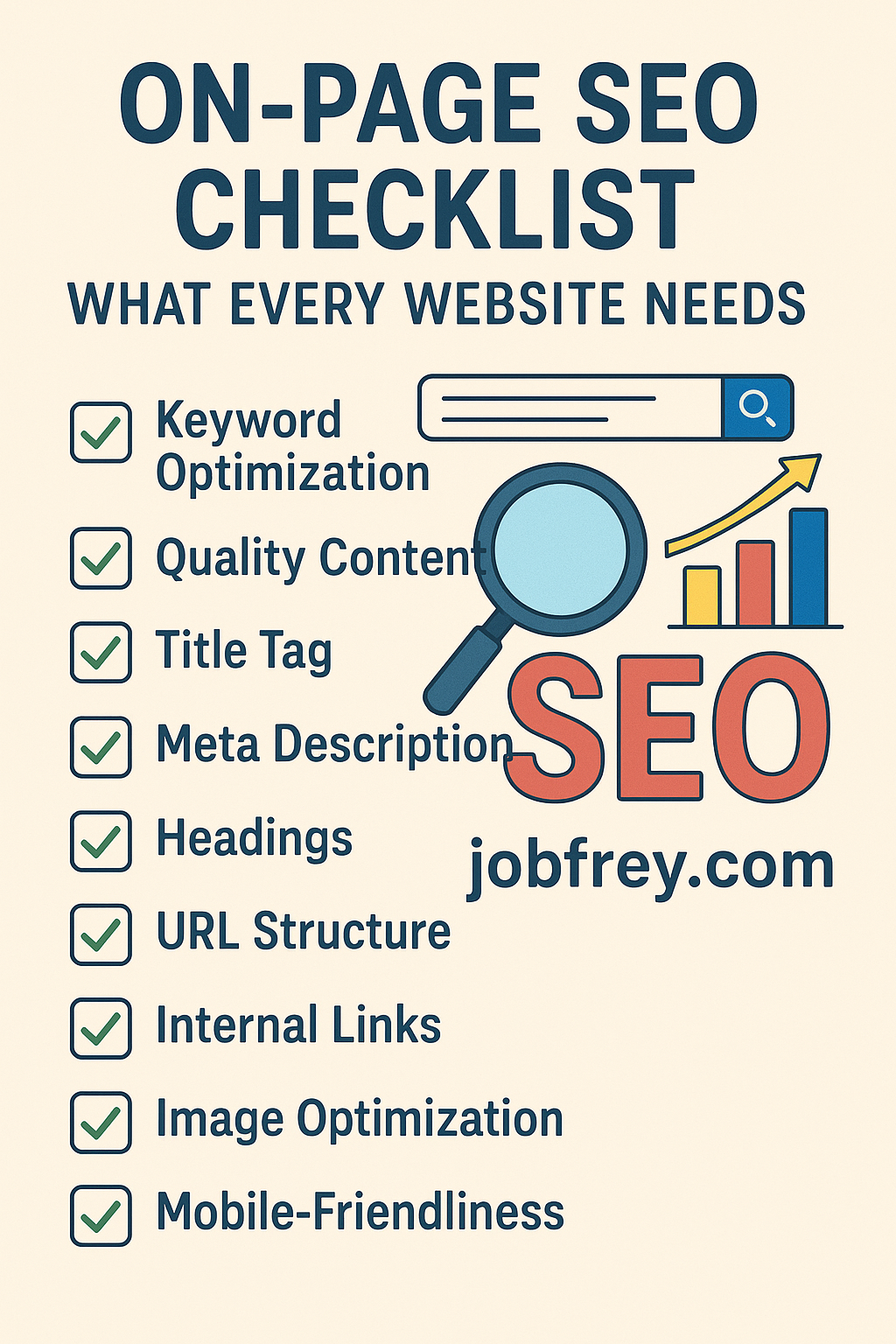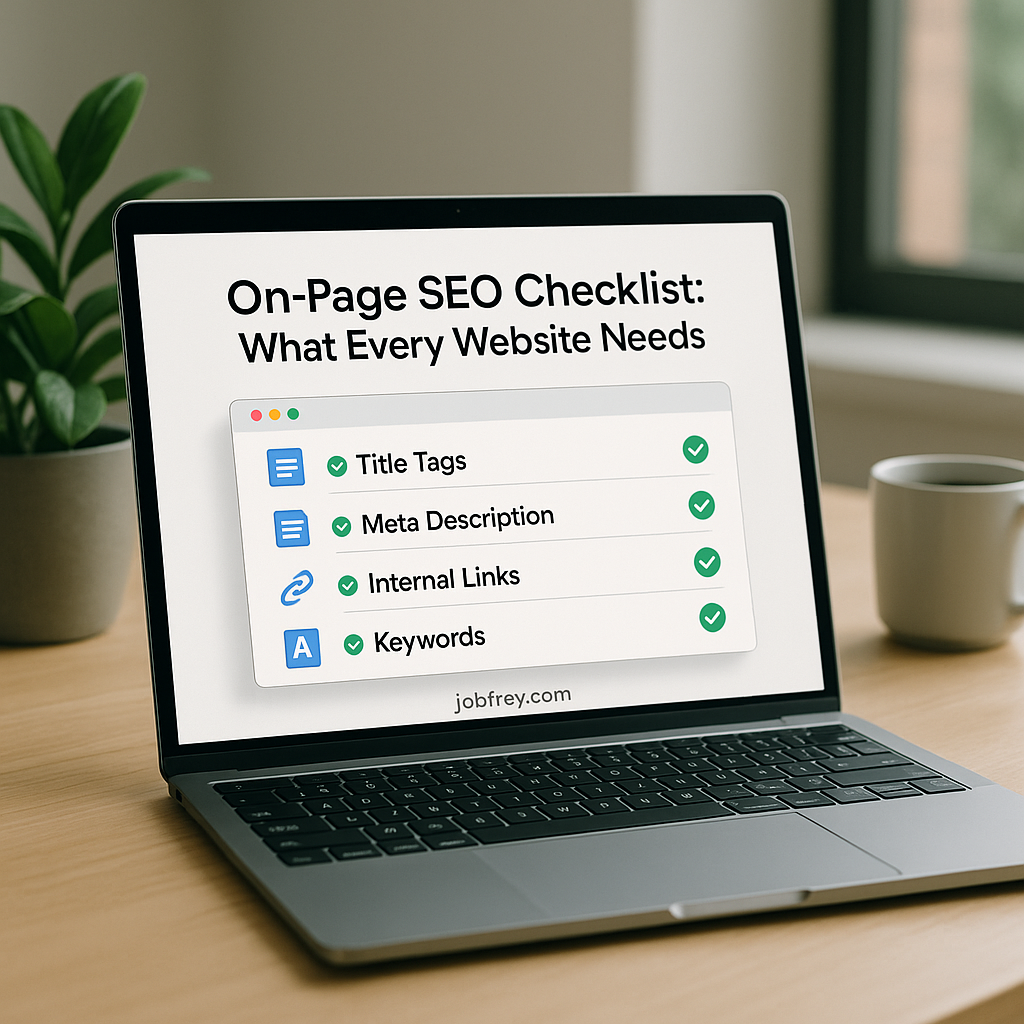Introduction to On-Page SEO
On-Page SEO Checklist What Every Website Needs refers to the optimization techniques that are applied directly within a website to enhance its visibility in search engine results. This aspect of search engine optimization is pivotal for bloggers as it plays a significant role in determining how well a site can perform regarding user engagement and search rankings. By focusing on on-page SEO, bloggers can improve their chances of being recognized by search engines, thereby drawing a larger audience and increasing their website’s overall effectiveness.
The core components of on-page SEO include the strategic use of keywords, quality content, and efficient site structure. Keywords are the phrases and terms that users are likely to input into search engines when looking for particular information. A proper understanding of keyword placement in titles, headers, and body text is vital to align a blog with the search intent of users. Implementing an SEO checklist centered around keywords can aid bloggers in ensuring they are effectively integrated into their content.
Moreover, content quality is integral to on-page SEO effectiveness. Creating valuable, informative, and engaging posts can not only improve user experience but also encourage visitors to stay on the page longer, reducing bounce rates. This quality ultimately signals to search engines that the content is worthy of high-ranking positions. Thus, utilizing an on-page SEO checklist to assess content relevance and depth is essential for any blogger aiming for success.
Finally, a well-structured site facilitates both user navigation and search engine crawling. A logical layout with proper use of internal links and a clear hierarchy can significantly support the technical aspects of SEO. Implementing a technical SEO checklist, alongside an effective local and technical SEO audit checklist, is necessary for optimizing site structure, ensuring that all elements work in harmony to create an efficient, search-friendly environment for users.

Keyword Research: The Foundation of SEO
Effective keyword research serves as the cornerstone of a successful SEO strategy, particularly for bloggers looking to optimize their websites. A well-implemented SEO checklist begins with understanding the language potential readers use when searching for information relevant to your blog. The first step involves utilizing various tools designed to aid in this research, such as Google Keyword Planner, Ahrefs, and SEMrush. These platforms enable you to uncover keywords that are not only popular but also relevant to your content.
In the realm of keyword research, the focus should not solely rest on high-traffic keywords. Instead, incorporating long-tail keywords is crucial. These more specific phrases often have lower competition and higher conversion rates. For instance, rather than targeting the broad term “travel,” a more focused keyword like “budget travel tips for solo travelers” could yield more targeted traffic. This aligns with the concept of user intent, which emphasizes understanding what the user is genuinely seeking when conducting a search.
Equipped with a robust SEO audit checklist, you can assess keyword difficulty, search volume, and trends over time. This analysis will also inform your content strategy, enabling you to create posts that directly address the needs and queries of your audience. Moreover, considering local SEO is important for bloggers who serve specific geographical areas. Incorporating location-based keywords into your on-page SEO checklist ensures that your content reaches the right audience.
Ultimately, refining your technical SEO checklist to prioritize relevant keywords and user intent can significantly improve your blog’s visibility in search engine results. By consistently following these principles, you can enhance your website’s performance and build a loyal readership.
Crafting Compelling Content
High-quality content plays an instrumental role in the effectiveness of an on-page SEO checklist. To create engaging and valuable blog posts, it is essential to focus on various aspects that enhance readability and search engine optimization simultaneously. One of the primary components of compelling content is the use of well-structured headlines and subheadings. This not only makes it easier for readers to navigate the post but also helps search engines understand the topic and context of the content, improving the chances of ranking higher in search results.
When crafting your headlines, incorporate relevant keywords to align with user search intent. This is vital in any seo checklist aimed at maximizing visibility. Additionally, breaking down content into digestible sections with subheadings enhances the reader’s experience. Each section should ideally address specific queries or topics relevant to your audience, which aligns with best practices outlined in a technical seo audit checklist.
Formatting techniques also significantly impact both user engagement and SEO performance. Utilizing bullet points, numbered lists, and proper spacing can make the content easier to read, which is instrumental in retaining your audience. Furthermore, integrating images, videos, and other multimedia elements creates a more dynamic reading experience and can improve the overall SEO optimization checklist effectiveness, as these elements often contribute to increased time spent on the page.
To ensure the originality of your blog content, it is crucial to conduct regular checks for plagiarism. Utilizing plagiarism detection tools can be beneficial and is a vital aspect of maintaining a unique voice. Continuous efforts in crafting original content not only adhere to your personal brand but also align with the broader goals set out in a local seo checklist. The credibility and authority gained through consistent, high-quality posts will ultimately reflect on your blog’s performance and visibility.
Optimizing Title Tags and Meta Descriptions
Title tags and meta descriptions play a crucial role in the overall SEO strategy of a blog. They serve as the first point of interaction between your content and potential readers on search engine results pages (SERPs). Optimizing these elements is essential for improving visibility and click-through rates, which ultimately contributes to the effectiveness of your SEO audit checklist.
When crafting title tags, it is important to keep them concise and relevant. Ideally, a title tag should be between 50 to 60 characters long. This length ensures that the entire tag will be displayed in search results without being cut off. Incorporating primary keywords related to your content within this character limit can significantly enhance your on page seo checklist. It is advisable to place the most significant keywords at the beginning of the title for better emphasis and to catch the attention of readers swiftly.
Similarly, the meta description should convey the essence of the content while also integrating key phrases that users would likely search for. Meta descriptions allow for a little more latitude in length, optimally ranging from 150 to 160 characters to avoid truncation. A well-written meta description not only reflects the content of the page accurately but also entices users to click through by highlighting the benefits of engaging with the post. Using action-oriented language can motivate readers, enhancing the appeal of your local seo checklist within the SERPs.
Finally, it is essential to avoid keyword stuffing in both title tags and meta descriptions. While incorporating relevant keywords enhances search visibility, overloading these elements may result in penalties from search engines. By adhering to best practices in crafting title tags and meta descriptions, you are effectively laying the groundwork for a successful technical seo audit checklist that enhances user experience and search engine ranking.

Utilizing Header Tags for Structure
Header tags play a crucial role in organizing content on blogs for both human readers and search engines. These tags, namely H1, H2, and H3, create a hierarchical structure that enhances content clarity and aids in the overall navigation of the page. By employing header tags effectively, bloggers can ensure their content is not only easy to read but also optimized for search engines, an important aspect of any comprehensive seo checklist.
The H1 tag is typically reserved for the main title of the blog post, serving as a strong indicator of the content’s primary focus. This tag is essential in establishing the topic of the post and should include relevant keywords to improve search visibility. Following the H1, H2 tags should be utilized for the main sections of the content. These subheadings provide clear markers that separate topics or ideas, making it easier for readers to scan through the article, which can positively impact user engagement metrics—an important element in any seo optimization checklist.
Additionally, H3 tags can be employed for subsections within H2 headings, providing even more granularity and detailed organization. Such structuring is beneficial not only for user experience but also for search engines that rely on header tags to determine the context and relevancy of the content. A well-structured piece will adhere to a logical flow, which is a key consideration in the technical seo audit checklist. Thus, blogs that incorporate header tags appropriately will likely perform better in search results, making proper usage of header tags integral to an effective on page seo checklist.
In conclusion, the strategic application of header tags is vital for enhancing content structure, clarity, and search engine compliance, ultimately leading to improved SEO performance.
Image Optimization Techniques
In the realm of on-page SEO, image optimization plays a crucial role in enhancing the overall performance of a blogger’s website. Optimizing images not only improves loading times but also contributes to better visibility in search engine results. One of the primary steps in this process is ensuring that image file names are descriptive and relevant to the content they represent. For instance, instead of using generic names like “IMG1234.jpg,” opt for more specific labels such as “blue-widget-product.jpg,” which can bolster your SEO checklist.
Equally important are ALT tags, which serve both accessibility and SEO purposes. These text descriptions provide context about an image for visually impaired users and search engines alike. When crafting ALT tags, it is essential to incorporate keywords that align with the content but to do so naturally without inducing keyword stuffing. Effective ALT tags not only help in improving your technical SEO audit checklist but also allow for better indexing of images by search engines, thereby increasing the chances of appearing in image search results.
File size is another critical factor to consider in your on-page SEO checklist. Large images can significantly slow down page loading speeds, which negatively impacts user experience and can lead to higher bounce rates. Therefore, it is advisable to compress images to reduce file size without sacrificing quality. Tools and plugins are available to assist bloggers in balancing image quality with load times, ensuring that images are optimized for quick loading while still maintaining visual appeal on the website.
Incorporating these techniques into your local SEO checklist and broader SEO optimization checklist can drastically enhance the effectiveness of your blogging strategy. By adhering to effective image optimization standards, you contribute to a more engaging user experience and improve search engine rankings, benefiting your overall web presence.
Internal Linking Strategy
Internal linking is a vital aspect of on-page SEO that plays a significant role in enhancing a blog’s visibility and usability. By strategically employing internal links, bloggers can connect related content, thereby improving site architecture and navigation. This practice not only helps users find relevant information more efficiently but also distributes page authority across the website, enhancing overall search engine optimization.
When creating an internal linking strategy, it is essential to consider the relationships between various posts. A well-structured internal link allows search engines to crawl the blog more effectively, ensuring that content is indexed properly. To implement this strategy effectively, one should first develop a comprehensive content inventory. This inventory can serve as the basis for identifying articles that are related and can benefit from interlinking.
Using suitable anchor text is equally important in this strategy. The anchor text used for internal links should accurately describe the linked content while incorporating relevant keywords to improve SEO. This integration is crucial because search engines rely on anchor text to understand what a linked page is about, thus aiding in the technical SEO audit checklist within the broader context of an SEO optimization checklist.
Moreover, it is prudent to regularly audit your internal links to ensure that they remain functional and relevant. Dead or broken links can negatively influence user experience and impede the effectiveness of the technical SEO audit checklist. Keeping your internal linking strategy up to date will not only optimize navigation for your readers but will also enhance the blog’s authority over time, contributing positively to your overall SEO checklist.

Mobile Responsiveness and Page Speed
In today’s digital landscape, mobile responsiveness and page speed are critical components of an effective SEO strategy. Mobile responsiveness ensures that your website provides an optimal viewing experience across a variety of devices, including smartphones and tablets. As more users access the internet via mobile devices, having a responsive design is no longer optional but a necessity for maintaining an edge in search engine rankings. Google prioritizes mobile-friendly websites, making it a significant factor in the overall SEO audit checklist.
To assess your website’s mobile responsiveness, you can utilize Google’s Mobile-Friendly Test tool. This tool evaluates your site and highlights any issues that could hinder a seamless mobile experience. A website that is mobile-friendly not only attracts more visitors but also improves user engagement, which is a key element in the on-page SEO checklist. Furthermore, a mobile-responsive site reduces bounce rates, as users are more likely to stay on a site that is easy to navigate on their devices.
Page speed is another vital aspect of SEO optimization, as slow-loading pages can negatively impact user experience and search engine rankings. Research indicates that a delay of even a few seconds can lead to higher bounce rates and lower conversions. To evaluate your site’s loading speed, you can use tools such as Google PageSpeed Insights or GTmetrix. These tools provide insights on your page’s performance and offer actionable recommendations to enhance speed. Implementing techniques such as image optimization, leveraging browser caching, and minimizing HTTP requests can significantly improve performance, aligning with the technical SEO checklist.
Enhancing mobile responsiveness and page speed are crucial steps for effective SEO. By following a comprehensive seo optimization checklist that includes these elements, you can create a user-friendly website that ranks well in search engine results, ultimately driving more organic traffic to your blog.
On-Page SEO Checklist: Quick Reference Table
For bloggers, implementing a comprehensive on-page SEO checklist is crucial for maximizing website visibility and attraction. This reference table will provide a streamlined set of actions that can be effortlessly integrated into your blogging routine to enhance search engine optimization. The following points summarize the essential strategies discussed in the previous sections:
| SEO Element | Action Item |
|---|---|
| Title Tags | Ensure unique and descriptive title tags that incorporate target keywords, adhering to 60-character limits. |
| Meta Descriptions | Craft compelling meta descriptions of up to 155 characters, including main keywords to improve click-through rates. |
| Headings | Utilize appropriate heading tags (H1, H2, H3) to structure content clearly and incorporate keywords effectively. |
| URL Structure | Maintain clean and descriptive URLs, including keywords where possible, to enhance user experience and crawlers’ understanding. |
| Image Optimization | Use descriptive filenames and alt text for images to boost visibility in search engines and provide context to visually impaired users. |
| Internal Linking | Incorporate internal links to relevant content, which supports site navigation and SEO by distributing page authority. |
| Keyword Placement | Strategically place primary keywords, along with related terms, throughout the content while ensuring natural readability. |
| Mobile Optimization | Ensure that the website is completely responsive and optimized for mobile devices, as this directly impacts search rankings. |
| Page Load Speed | Utilize tools to assess and improve page loading times, as faster websites tend to rank better in search results. |
This on-page SEO checklist serves as a technical SEO audit checklist that bloggers can refer to frequently. By systematically addressing each of these focal points, bloggers can significantly enhance their website’s search engine performance, ensuring a robust framework that supports ongoing SEO optimization efforts.

